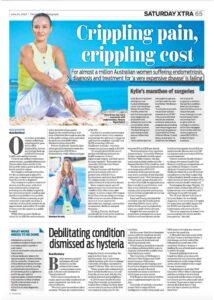Endometriosis Australia in the news
Endometriosis in Australia is now estimated to be 1 in 7 females and those assigned female at birth
OVERVIEW OF ENDOMETRIOSIS in AUSTRALIA
AIHW Report 2023
Current Statistics on Endometriosis
1 in 7 females and those assigned female at birth, or 14% of girls and women in Australia are now estimated to live with Endometriosis, up from 1 in 9 and 11 percent. This is based on those diagnosed with the condition by age 44 to 49.
Challenges in Diagnosis and Treatment
Endometriosis Australia welcomes the AIHW Endometriosis in Australia report and suggests that while there is an increase in the diagnosis of this progressive, chronic and incurable condition, the average time between the onset of symptoms and diagnosis is still 6 and 8 years with surgical intervention taking even longer.
According to Endometriosis Australia Medical Director Assoc Prof Anusch Yazdani, “For those without private health insurance, the delay in accessing the laparoscopic surgery required to diagnose and treat the condition results in prolonged pain and impacts their quality of life and employment opportunities.
The median time to surgical intervention still shows women waiting too long. Surgical intervention is an important diagnostic step for women with endometriosis, the diagnosis itself can be therapeutic, offering validation for a woman who has suffered for many years.
As a result, around 1 in 10 self-fund their surgery. This AIHW Endometriosis in Australia Report identifies that almost two-thirds, 68% of endometriosis-related hospitalisations took place in a private hospital, 28% were for public patients.” he said.
Disparities in Endometriosis Hospitalisations
The report also shows a lower rate of endometriosis-related hospitalisations among First Nations people – 2.5% compared with 5.9% of all female hospitalisations.
There were 40,500 endometriosis-related hospitalisations in 2021–22 and endometriosis was the 20th most common reason for hospitalisation among those aged 15–44. People living in lower socioeconomic areas and remote areas of Australia also had a lower rate of endometriosis-related hospitalisations, but further work is needed to understand the impact of endometriosis on priority populations, particularly those who face barriers to accessing health care services.
Emergency Department Visits and Hospitalisations
According to the report, around 71% of endometriosis-related Emergency Department presentations in 2021–22 ended with the patient leaving the hospital without being admitted or referred to another hospital.
Increasing Awareness Among Younger Women
Endometriosis Australia is the main resource for those needing trustworthy, reliable, up-to-date information on endometriosis. According to CEO Maree Davenport, the rate of hospitalisations for the condition has doubled among women aged 20 to 24 over the past decade.
“Younger women are more empowered, they know it’s not ok to put up with the pain of endometriosis, and the impact to education, work, personal relationships and social life. It is crucial they can access empirical evidence. We see younger women looking to friends, social media such as Tik Tok hearing symptoms others talk about. It is important we communicate in clear and accessible ways, so they know how and where to seek medical advice and treatment.”
Progress and Ongoing Challenges
“While the AIHW report highlights women are being diagnosed with endometriosis at a younger age, there is still work to be done to provide the diagnosis, pain relief and long-term management of endometriosis to reduce the impact on a woman’s fertility and overall quality of life. The clear trend to younger women presenting and being diagnosed with endometriosis is not a change in pattern of disease rather a reflection of the fact that younger women are empowered to seek help and not accept the pain of endometriosis,” said Assoc Prof Anusch Yazdani.
The AIHW report shows while the overall time from symptoms to endometriosis diagnosis is reducing slowly, women are still waiting too long for effective surgical intervention and overall management of this progressive, chronic condition endometriosis.
By age 31, 9.2% of women born between 1989 (aged 34) and 1995 (aged 28), were diagnosed with endometriosis, compared with 6.9% of women born between 1973 (aged 50) and 1978 (45) at the same age.
According to Assoc Professor Yazdani, a fertility specialist, “The delay in diagnosis is having a knock-on effect, with 50% of women diagnosed with Endometriosis having fertility challenges.”
Researchers at the University of Queensland used data from the Australian Longitudinal Study on Women’s Health, along with health service data, to estimate the prevalence of endometriosis.
Research and Funding Insights
Ms Davenport noted that The National Health and Medical Research Council has expended only $18.9 million towards research relevant to endometriosis between 2000 and 2022, and MRFF has funded only 11 grants with a focus on endometriosis research since its inception in 2015. “This is significantly below the investment in diabetes, which is as common as endometriosis – a gendered disease, with no lifestyle modifications to alleviate symptoms and no cure.” she said.
“Community awareness, education of priority populations with intersectional disadvantage, and medical support is required lead by specialists in the field, Endometriosis Australia. First Nations women in have less access to medical care, with the rate of endometriosis-related hospitalisations 2.5% among First Nations women, compared with 5.9% of all female hospitalisations.” she continued.
Economic Burden of Endometriosis
The AIHW report notes the total economic burden of endometriosis has been estimated at between $7.4 billion and $9.7 billion per year (Armour et al. 2019; Ernst & Young 2019)
The estimated cost of endometriosis was $30,900 per person with the condition in 2017 (Armour et al. 2019). This consisted of:
- $25,800 for productivity costs
- $3,900 for total health costs
- $1,100 for carer costs.
Lost productivity due to endometriosis accounted for 84% of these costs. Costs increased with pain severity, with costs for people reporting severe pain 6 times as high as those reporting minimal pain.
Ms Davenport notes “The cost of under or unemployment, casualised jobs impacts the financial security of females living with endometriosis, and their ability to pay for treatment and health insurance.”
Workplace Impact and Solutions
According to Western Sydney University research with Endometriosis Australia,
- one in six people with endometriosis will lose their employment due to managing the disease.
- one in three will be overlooked for a promotion.
- 70% have to take unpaid time off work to manage symptoms.
- 50% said lack of workplace flexibility was a significant problem.
- 79% reported that work-from-home protocols made managing their symptoms easier.
- 60% said they will be more productively working from home.
- 90% thought flexibility in hours and working from home could improve their management of endo in the workplace.
Endometriosis Australia has developed a Workplace Accreditation Program to empower organisations to sustainably and strategically take meaningful action to support their employees with endometriosis.
“Our workplace assistance program is based around the core pillars of Process, Policy and Promotion, EndoAware Workplace Accreditation provides tangible and practical benefits for employees suffering from endometriosis and employers, ultimately improving productivity and wellbeing for staff and their workplaces.” Ms Davenport said.
MAGAZINE ARTICLES
Herald Sun

The Advertiser

Daily Telegraph

Courier Mail

CONTACT US
Media enquiries: media@endoaustralia.org






